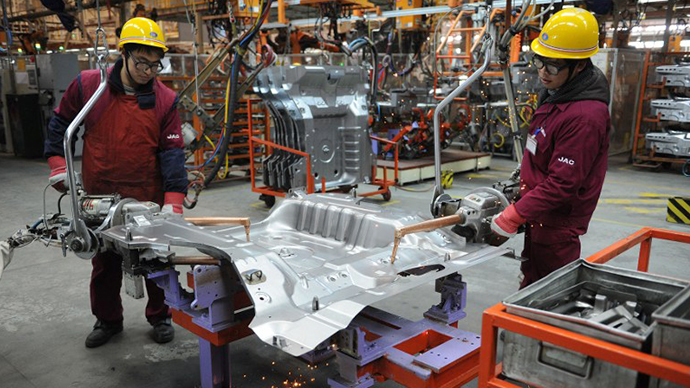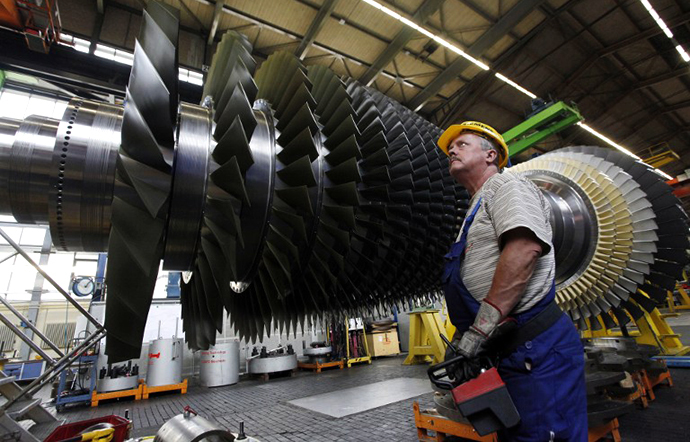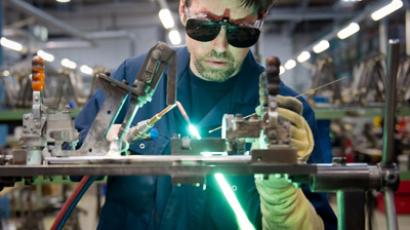June manufacturing: From disappointing China to inspiring Europe

World manufacturing offered mixed picture in June. While HSBC’s PMI barometer showed China slowed for the 2nd month running, Europe started to inspire hope of a recovery. Russia was up, but still under the pressure of a weak global economy.
HSBC’s Purchasing Managers’ Index (PMI) for China – an indicator of business environment - declined to 48.2 points on a 100-point scale, where numbers below 50 show a contraction. This marked a slowdown from May's 49.2. A separate measure by the state-sanctioned China Federation of Logistics and Purchasing declined to 50.1 from May's 50.8.
New export orders suffered their sharpest decline in nine months, and manufacturers shed jobs at their fastest rate in 10 months, according to HSBC.
China's vast industry of privately owned small manufacturers was especially hit by a shortage of credit in June. Chinese regulators are now trying to cool a lending boom they worry could race out of control. The authorities want banks to reduce profitable but risky unreported lending, much of which goes to entrepreneurs who cannot qualify for formal loans. A shortage of cash in financial markets caused interest rates paid by banks for loans from other banks to spike to a record high.
“As Beijing refrains from using stimulus, the ongoing growth slowdown is likely to continue in the coming months,” said HSBC economist Hongbin Qu.
The pace of economic growth in Beijing has been slowing down. The number decelerated to 7.7 percent in the first quarter of 2013 from 7.9 percent in the previous quarter. Experts say the clampdown on bank lending could cause growth to dip below 7 percent in coming quarters, which would mark China's weakest performance since the early 1990s.
China is now seeking to build a self-sufficient economy where domestic consumption is set to become a key driver of growth rather than exports and investment. In 2012 exports of goods and services in China comprised 31% of its GDP, according to data from the World Bank.
Chinese President Xi Jinping was quoted by state media on Saturday as saying officials should not be judged just by increases in economic output, which means China's Communist leaders are prepared to tolerate slower growth.
The slowdown in Chinese manufacturing could have global repercussions, depressing demand for iron ore and other commodities from Australia and Brazil, and for industrial components from Southeast Asia, Taiwan and South Korea.
In Russia, June PMI reached a four-month high. The reading was up to 51.7 This compares to 50.4 in May. Increased consumer demand by Russians was the main driver behind the improvement, according to the HSBC report. Overall, new orders, that also include foreign demand, grew the fastest since February.
However, Alexandr Morozov, HSBC Chief Economist for Russia and CIS, kept the optimism in check.
“Obviously, it would be wrong to assume that manufacturing and industrial growth in Russia is set to strengthen further from now on. Although export demand edged up again in June, the global economy is not in a great shape, posing downside risks for Russia,” Morozov said

Easing Europe
The Eurozone manufacturing figures showed the area’s contraction was slowing. Though the seasonally adjusted PMI remained below the dividing line of 50 points in June, the indicator rose to a 16-month high of 48.8 in the month, up from 48.3 in May.
Across the currency union, Austria and Greece were the worst performers, though dynamics in the latter was inspiring; a 24 month high in June. Germany, the area’s economic powerhouse, was the only one where manufacturing failed to grow in June. However, the PMI figure remained comparatively solid at 48.6.

The sky - high Eurozone unemployment rate persists a great concern. Monday's report by the Europe’s key statistic service Eurostat said unemployment across the 17 countries that use the euro hit another record high in May. The number was up to 12.1% from 12% in April.
"With the region suffering from record - high unemployment, the ongoing decline in manufacturing head counts is a disappointment, and suggests the jobless rate has yet further to climb,” commented Chris Williamson, Chief Economist at Markit.
Beyond the Eurozone but still within the EU, manufacturing in the United Kingdom showed robust performance. Its PMI figure was at 52.5 in June, which marked the steepest improvement in 25 months. Increased orders from both within the country and foreign clients based in Europe, China, North America, Scandinavia and the Middle East came as a key growth trigger. Nevertheless, manufacturing employment remained a disappointment, and almost unchanged from the latest figures. The UK Office for National Statistics showed that the jobless total dipped to 2.51 million in the three months to April, at 7.8%.














